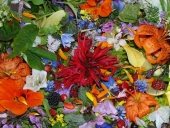


Dylan Mulder wrote:I could not live without garlic chives (Allium tuberosum), or it would be more accurate to say that my system could not live without garlic chives.
Apart from being delicious, garlic chives are my most successful pest control plant. They draw a great myriad of wasps, in particular the blue winged wasp (Scolia dubia) which is a vigilant predator of the Japanese beetle (Popillia japonica).
It also attracts the Pennsylvania leatherwing (Chauliognathus pensylvanicus) in great adundance, which predate a number of other insects such as aphids.








